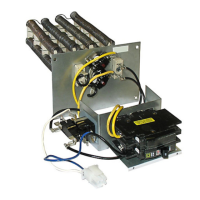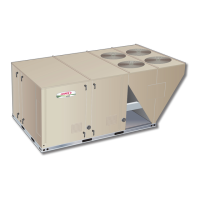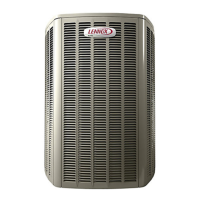
Do you have a question about the Lennox ECB29 Series and is the answer not in the manual?
| Brand | Lennox |
|---|---|
| Model | ECB29 Series |
| Category | Air Conditioner |
| Language | English |
Ensure all power supplies are disconnected before performing any servicing or maintenance.
Verify all parts and panels are correctly replaced before operating the unit.
Installation and service must be performed by a licensed professional HVAC installer or equivalent service agency.
Handle equipment with care to avoid injury from sharp sheet metal edges; wear gloves and protective clothing.
Inspect equipment for shipping damage immediately and contact the carrier if damage is found.
Describes the ECB29 series electric heat section, its field-installation capability, and single/three-phase availability.
Consult model-specific bulletins for detailed air handler product specification and heat section applications.
Follow these general instructions but prioritize local codes and consult authorities before installation.
Always disconnect power before installation/service and use appropriate tools and protective equipment.
Installation must comply with NFPA standards, manufacturer's instructions, and local building codes.
Verify unit rating plate, electrical power availability, and duct clearances before installing the heat section.
Install the electric heat section inside the air handler before the unit is set and the plenum is attached for ease.
Ensure all power to the air handler is shut off; multiple disconnects may be necessary.
Take off the air handler's access panel to gain entry for installation.
Remove the appropriate electric heat knockout from the vestibule panel for heater installation.
Slide the heat section into the air handler, aligning holes, and secure it with provided screws.
Modifications are needed for 460V ECB29-10F-G/15F-G heat sections in 460V, 3-ton air handlers.
Tabs on 460V, 3-ton air handlers obstruct the installation of specific ECB29 electric heat sections.
The solution is to remove the identified tabs that are restricting the electric heat section installation.
Ensure proper grounding and disconnect all remote power supplies before accessing the unit's components.
Install the circuit breaker onto the air handler deck flange using the provided six screws.
In downflow applications, circuit breakers must be rotated 180 degrees to the UP position.
Remove the circuit breaker patch plate from the air handler access panel.
Apply the adhesive-backed seal to the access panel to ensure an airtight fit around circuit breakers.
Break and secure the patch plate to fit the specific size of the electric heat section being installed.
Illustrates circuit breaker and patch plate configurations for specific models in small air handler cabinets.
Shows typical circuit breaker and patch plate configurations for common electric heat section models.
Clean the surface where the circuit breaker cover will be attached using isopropyl alcohol.
Apply a thin silicone bead to ensure an airtight seal between the cover and the access panel.
A proper seal prevents warm, moist air from entering the control panel, avoiding condensation.
Ensure that only copper conductors are used for all electrical connections.
Use 1-1/2 inch conduit; consult unit nameplate and NEC/CEC tables for proper circuit ampacity and protection.
Disconnect the air handler interface harness and connect the heater plug to the matching indoor plug.
For 575V heaters, connect the provided transformer between the air handler interface harness and its transformer.
For two-stage thermostats, connect the second-stage heat bulb lead to W2 and remove the R-W2 jumper.
If using an outdoor thermostat, connect leads to W2 and R, removing the R-W2 jumper.
Connect field power supply wiring directly to the circuit breaker(s).
Connect field power supply wiring to the designated terminal block(s).
Connect field power supply wiring to the fuse block for 460V/575V, 3-phase heaters.
Restore power, set the thermostat heat anticipator to 0.4 amps, and set it above room temperature.
Align and affix the provided wiring diagram sticker to the blower housing.
Check the system for normal operation and then set the thermostat to the desired temperature.
Adjust blower speed based on the electric heat and air handler unit size; HIGH is the minimum setting.
Refer to figures for typical field wiring of air handlers with electric heat in cooling applications.
Refer to figures for typical field wiring of air handlers with electric heat in heat pump applications.
Cross-reference table linking specific electric heat section models to their corresponding wiring diagram numbers.












